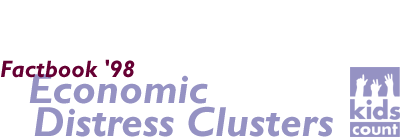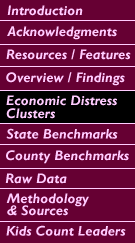

|
 |
 Copyright 1998 Oklahoma Institute for Child Advocacy, Inc. 420 NW 13th Street, Suite 101 Oklahoma City, Oklahoma 73103 Phone: 405-236-KIDS Fax: 405-236-KIDX |
Narrative Map and Legend showing each of the 77 counties. Counties are placed in one of the following economic clusters: wealthiest, wealthier, middle, poorer, or poorest. Two-page pdf file (477K) with narrative, map and legend, and a chart comparing the five economic clusters. Comparison is based on the eight state benchmarks and other economic factors. On to State Benchmark Topics The 1998 Oklahoma Kids Count Factbook again divides Oklahoma's 77 counties into five clusters with similar conditions based on four economic factors: Child Poverty Rates (1993 Census Estimates): the best measure of the presence of very poor children in a community; Per Capita Personal Income (1995): the most current measure of income levels of people in a community; Percent of Children on Welfare (FY 1996): the most current measure of children required to survive on inadequate resources; Unemployment Rates (1995): the best measure of people's ability to improve economic conditions through work. Taken together, these factors provide a comprehensive picture of a county's economic status in a manner which can be ranked, grouped into clusters, updated and tracked from year to year. Each county is ranked on each of the four factors. The four individual county rankings are combined into a "Deprivation Index" in which the lower the number, the wealthier the county. Each county was ranked again according to its "Deprivation Index" and grouped into one of five economic clusters: wealthiest, wealthier, middle, poorer or poorest. Each cluster is composed of approximately twenty percent (20%) of the state's population. (View Map and Legend) These five clusters illustrate the diverse economic environments in which Oklahoma children live. While many Oklahoma counties moved from one cluster to another during the most recent year investigated, Oklahoma's wealthiest counties are still primarily concentrated in the northwestern corner of the state. The poorest counties are still primarily concentrated in the southeastern corner but are now also frequently found in the southwestern region of the state. Similar to last year, the profiles of the five clusters continue to reveal clear patterns in Oklahoma's economic landscape. Children in Oklahoma's poorest counties are more than twice as likely to be poor, and almost three times as likely to be on welfare as children in the state's wealthiest counties. In these poorest counties incomes plummet and unemployment rates more than double. Poverty is harder to escape. The cluster of Oklahoma's 22 wealthiest counties has the best indicators in six of the eight benchmark areas investigated by Oklahoma Kids Count. Taken together these counties have the lowest rates of low birthweight infants, infant mortality, births to teens, child death and juvenile violent crime arrests. The state's lowest rate of child abuse & neglect confirmations is found in the cluster of Oklahoma's seven counties comprising the state's wealthiest areas. Surprisingly, the high school dropout rate is the lowest in the 27 counties making up Oklahoma's most economically deprived area. Back to Top of Page |
  Web access launched March 24, 1998 |